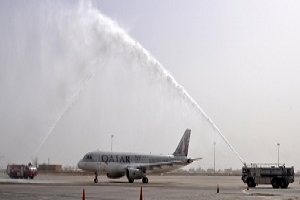The deterioration of Iraq's great Nimrud

|

|
|
By Martin Bailey The Art Newspaper 22 April, 2004
A cache of Iraq's greatest and most valuable antiquities is deteriorating in the vaults of the central bank in Baghdad.
The Art Newspaper can reveal that the exquisitely carved Nimrud Ivories have been suffering from dampness, following flooding by sewage-contaminated water last April, during the fighting. It is now clear that this has already caused some fragmentation and mould.
Among the ivory treasures dating from the eighth and ninth centuries BC is the famed 'Mona Lisa' mask, discovered by Max Mallowan in 1951 in the North-West Palace of the Assyrian kings. He was accompanied by his wife, Agatha Christie, who cleaned the Nimrud Ivories, using face lotion. Other ivories were excavated at the site by Iraqi archaeologists, including some magnificent examples in 1975.
The ivories are not only valuable, they are also easily portable. At the time of the first Gulf War in 1990 they were moved from the National Museum in Baghdad to the central bank, along with the Nimrud Gold, for their protection. After the vaults were opened last June, the tin trunk containing the boxed ivories was immediately moved to a drier room within the underground complex. Baghdad museum staff then spent several days cleaning and air-drying the ivories. However, the ivories were only superficially dried before they were repacked in fresh cardboard boxes.
Unfortunately, environmental conditions in the vaults remain poor, since it is cold in winter and hot in summer. It also still a damp environment. The ivories are, therefore, drying extremely slowly, a process which, from a conservation point of view, ought to have been completed many months ago because damp conditions often lead to the growth of mould.
Since last June, the ivories have been inspected only twice, most recently in December. These visits have lasted only a couple of hours, which has enabled a proper examination of just part of the collection. There could well be hundreds of ivories in store in the bank vault, objects which are the very crوme de la crوme of the National Museum’s collection.
Signs of mould were detected in December. This needs to be treated promptly, and it could result in some permanent staining. The ivories are also fragmenting as they dry out. In some cases, this is along old break lines, where they were consolidated with PVA glue in the 1950s, but there may well be new cracks and splits. If the ivories receive proper conservation treatment and are consolidated, they should remain stable, although they will be vulnerable if they are ever again subjected to poor environmental conditions or rough handling.
Theoretically, the ivories could be moved to a location in Baghdad with better environmental conditions and where they could be monitored regularly. Conservators would normally want to keep these fragile objects in a controlled environment, but Baghdad’s erratic electricity supply means that this is not necessarily the best option, unless an emergency generator is available. The overwhelming consideration is security, and there is little doubt that the central bank vault is among the most secure in the city.
Another option would be to move the ivories abroad, to a properly equipped laboratory with specialist staff. A precedent for this was the transfer last year of a collection of historic Judaica found in the headquarters of Saddam Hussein’s secret police in Baghdad to the National Archives in Washington, DC. American conservators are now restoring the manuscripts and documents (The Art Newspaper, No.143, January 2004, p.10). This course of action would need to be approved by the Iraqi authorities, but in the present circumstances the idea would be controversial.
A proposal has been made to tour the other treasures currently in the bank vault, the Nimrud gold, but some Iraqis feel the gold should first be exhibited in Baghdad. Nevertheless, the National Museum is in discussions with the Copenhagen-based United Exhibits Group over the gold show, a venture which would bring the museum much needed funds.
Another idea which could be explored would be to expand the gold exhibition to include the ivories, and conserve them abroad as part of the arrangement. But there is then the danger that transporting the ivories could result in further fragmentation. In any case, conservation would obviously have to be completed before they go on show.
In the present political circumstances, it seems that leaving the Nimrud ivories in the bank vaults may be the best solution, despite the danger of further mould growth.
It is, however vital that specialists have regular access to the antiquities in order to monitor conditions. Once the Nimrud ivories are properly dried, they will still require urgent conservation to prevent further damage.
|
| Back to main page
|
|
|
|
.jpg)
Emirates Arrives in Erbil
Emirates, one of the world’s fastest-growing airlines, today commenced its new non-stop service between Dubai and Erbil city in Iraq, making it the 11th destination launched by the airline this (12/08/2012)
|
|

Qatar Airways Begins FlightsTo BAGHDAD
The Doha-based airline is operating four-flights-a-week non-stop on the Baghdad route. Located on the banks of the Tigris River, Iraq’s capital is one of the Arab world’s largest cities. (09/06/2012)
|
|
Showing 5 news articles
Back
To Top
Baghdad Office / Agents
Mr. Walid Abdul-Amir Alwan
Bab Al-Mudham
P.O. Box 489, Baghdad - Iraq
Mobile: +964 790 183 1726,
E-mail: itmbaghdad@tcph.org
|
ÈÛÏÇÏ
ÇáÓíÏ æáíÏ ÚÈÏ ÇáÃãíÑ ÚáæÇä
ãßÊÈ ÈÑíÏ ÈÇÈ ÇáãÚÙã
Õ.È 489 ÈÛÏÇÏ – ÇáÚÑÇÞ
|

|

|
